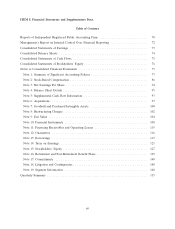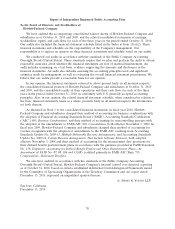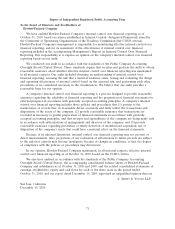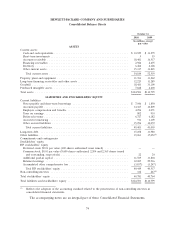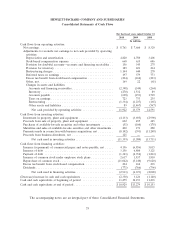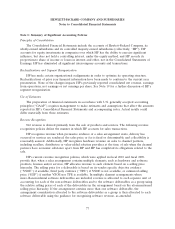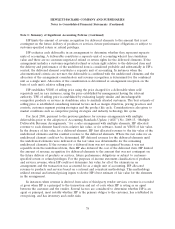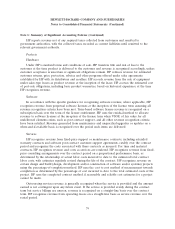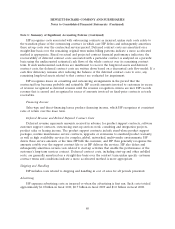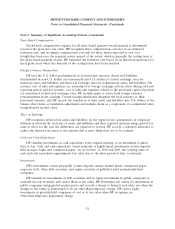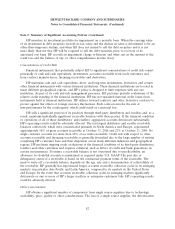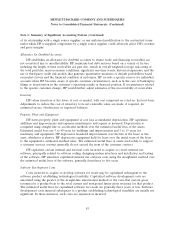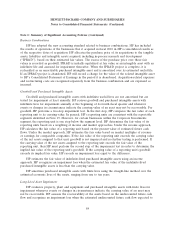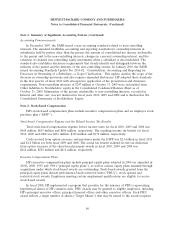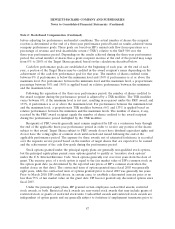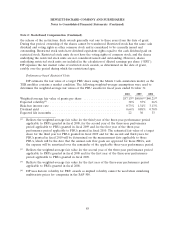HP 2010 Annual Report Download - page 86
Download and view the complete annual report
Please find page 86 of the 2010 HP annual report below. You can navigate through the pages in the report by either clicking on the pages listed below, or by using the keyword search tool below to find specific information within the annual report.HEWLETT-PACKARD COMPANY AND SUBSIDIARIES
Notes to Consolidated Financial Statements (Continued)
Note 1: Summary of Significant Accounting Policies (Continued)
HP limits the amount of revenue recognition for delivered elements to the amount that is not
contingent on the future delivery of products or services, future performance obligations or subject to
customer-specified return or refund privileges.
HP evaluates each deliverable in an arrangement to determine whether they represent separate
units of accounting. A deliverable constitutes a separate unit of accounting when it has standalone
value and there are no customer-negotiated refund or return rights for the delivered elements. If the
arrangement includes a customer-negotiated refund or return right relative to the delivered item and
the delivery and performance of the undelivered item is considered probable and substantially in HP’s
control, the delivered element constitutes a separate unit of accounting. In instances when the
aforementioned criteria are not met, the deliverable is combined with the undelivered elements and the
allocation of the arrangement consideration and revenue recognition is determined for the combined
unit as a single unit. Allocation of the consideration is determined at arrangement inception on the
basis of each unit’s relative selling price.
HP establishes VSOE of selling price using the price charged for a deliverable when sold
separately and, in rare instances, using the price established by management having the relevant
authority. TPE of selling price is established by evaluating largely similar and interchangeable
competitor products or services in standalone sales to similarly situated customers. The best estimate of
selling price is established considering internal factors such as margin objectives, pricing practices and
controls, customer segment pricing strategies and the product life cycle. Consideration is also given to
market conditions such as competitor pricing strategies and industry technology life cycles.
For fiscal 2008, pursuant to the previous guidance for revenue arrangements with multiple
deliverables prior to the adoption of Accounting Standards Update (‘‘ASU’’) No. 2009-13, ‘‘Multiple
Deliverable Revenue Arrangements,’’ for a sales arrangement with multiple elements, HP allocated
revenue to each element based on its relative fair value, or for software, based on VSOE of fair value.
In the absence of fair value for a delivered element, HP first allocated revenue to the fair value of the
undelivered elements and the residual revenue to the delivered elements. Where the fair value for an
undelivered element could not be determined, HP deferred revenue for the delivered elements until
the undelivered elements were delivered or the fair value was determinable for the remaining
undelivered elements. If the revenue for a delivered item was not recognized because it was not
separable from the undelivered item, then HP also deferred the cost of the delivered item. HP limited
the amount of revenue recognition for delivered elements to the amount that was not contingent on
the future delivery of products or services, future performance obligations or subject to customer-
specified return or refund privileges. For the purposes of income statement classification of products
and services revenue, when HP could not determine fair value for all of the elements in an
arrangement and the transaction was accounted for as a single unit of accounting, HP allocated
revenue to products and services based on a rational and consistent methodology. This methodology
utilized external and internal pricing inputs to derive HP’s best estimate of fair value for the elements
in the arrangement.
In instances when revenue is derived from sales of third-party vendor services, revenue is recorded
at gross when HP is a principal to the transaction and net of costs when HP is acting as an agent
between the customer and the vendor. Several factors are considered to determine whether HP is an
agent or principal, most notably whether HP is the primary obligor to the customer, has established its
own pricing, and has inventory and credit risks.
78



